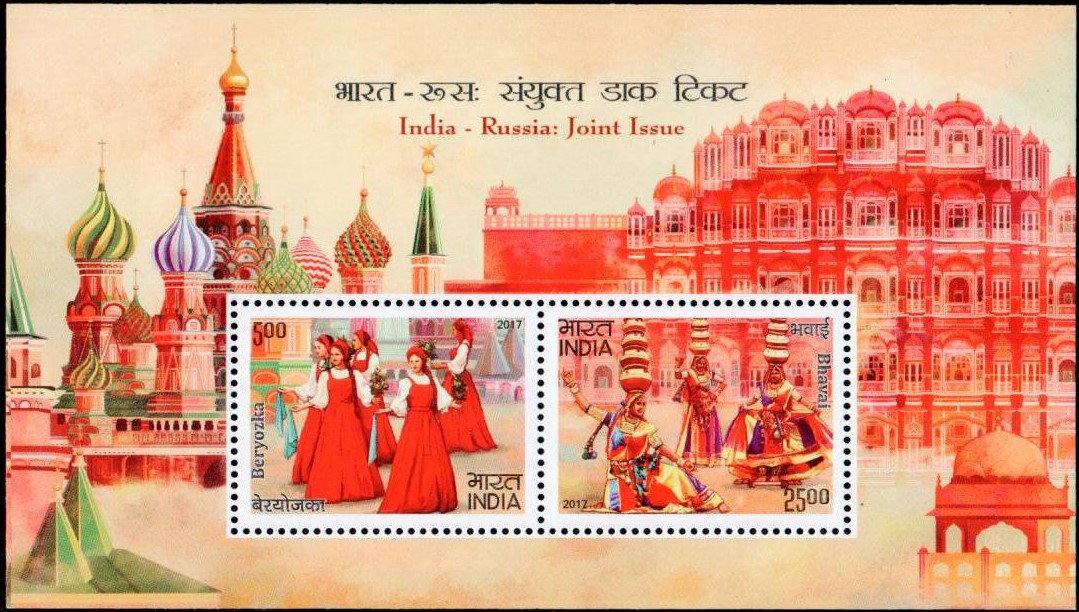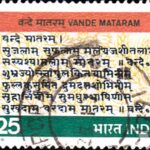
India-Armenia : Joint Issue
Complete set of 2 nos. of commemorative postage stamps on India–Armenia : Joint Issue : Manipuri Dance and Hov Arek Dance :


 Issued by India
Issued by India
Issued on Aug 29, 2018
Issued for : Department of Posts is pleased to release a set of two Commemorative Postage Stamps between India and Armenia on the theme Dance featuring ‘Manipuri Dance’ of India and ‘Hov Arek Dance’ of Armenia.
Credits :
Stamps/Miniature Sheet/FDC/Brochure : Shri Suresh Kumar
Cancellation Cachet : Smt. Nenu Gupta
Type : Miniature Sheet, Mint Condition
Colour : Multi Colour
Denomination : 2500, 500 Paise
Stamps Printed : 500250 each
Miniature Sheet Printed : 1.1 lakh
Printing Process : Wet Offset
Printer : Security Printing Press, Hyderabad
About :
- India recognized Armenia on 26th December, 1991 and the Protocol on establishment of diplomatic relations between India and Armenia was signed on 31st August, 1992 in Moscow. Historians have suggested that when Assyrian warrior queen Semiramis invaded India in 2000 BC, some Armenians accompanied her as they probably did Alexander the Great in 326 BC. According to literary evidence, there were Indian settlements in Armenia established by two Indian Princes who along with their families and large retinue had arrived in Armenia as early as 149 BC and were allotted land in Taron region (now in Turkey) by the then rulers of Armenia.
- Emperor Akbar, highly appreciative of the commercial talents and integrity of the Armenians, granted them numerous privileges and considerable religious freedom as also an opportunity to serve in his empire in various capacities. In the 16th century, Armenian communities emerged in Kolkata, Chennai, Mumbai and Agra, where the first Armenian Church was consecrated in 1562. The Armenian language journal “Azdarar” published in Madras (Chennai) in 1794 was the first ever Armenian journal published anywhere in the world. The vestigial Armenian community in India is now mainly settled in Kolkata. The Holy Church of Nazareth, erected in 1707, repaired and embellished in 1734 is the biggest and the oldest Armenian Church in Kolkata.
- Bilateral dialogue between India and Armenia is conducted through the mechanisms of Foreign Office Consultations (FOC) and Inter-Governmental Commission on Trade, Economic, Scientific and Technological, Cultural and Educational Cooperation (IGC), and periodic high-level interactions. In recent years, India and Armenia have supported each other in international organizations. India’s exports to Armenia were USD 19.87 million in 2017 and imports in the same period were USD 2.83 million.
- The first International Day of Yoga was celebrated in Armenia on 21st June, 2015 in which over 300 Armenians from different walks of life participated. The event created awareness about yoga benefits among Armenians. International Day of Yoga was again celebrated in 2016 and 2017.
- India has set up a Centre of excellence in ICT in Yerevan and supported projects for supply of computers to schools in Armenia. India offers India Technical Economic Cooperation (ITEC) courses to Armenians and also scholarships to study Hindi in the Kendriya Hindi Sansthan (KHS). The Indian community in Armenia is small and consists largely of over 800 students pursuing medical education at Yerevan State Medical University and Yerevan Engineering & Polytechnic University.
- Manipuri Dance:
- Manipuri dance is one of the major Indian classical dance forms, named after the region of its origin Manipur, a state of North Eastern India. It is particularly known for its Hindu Vaishnavism themes and exquisite performances of love-inspired dance drama of Radha–Krishna called Raslila. However, the dance is also performed on themes related to Shaivism, Shaktism and regional deities such as Umang Lai during Lai Haraoba. The Manipuri dance is a team performance, with its own unique costumes, aesthetics, conventions and repertoire. The Manipuri dance drama is, for the most part, marked by a performance that is graceful, fluid, sinuous with greater emphasis on hand and upper body gestures. It is accompanied by devotional music created with many instruments, with the beat set by cymbals (kartal or manjira) and double-headed drum (pung or Manipuri mridanga) of sankirtan. Manipuri dance is a religious art and its aim is the expression of spiritual values. Aspects of this performance are celebrated during Hindu festivals and weddings among the Manipuri people, particularly in the ethnic majority of Meitei people. The dance drama choreography shares the plays and stories of ‘Vaishnavite Padavalis’, that also inspired the major Gaudiya Vaishnava related performance arts found in Assam and West Bengal.
- Hov Arek Dance:
- The Armenian dance heritage has been considered one of the oldest and most varied. From the fifth to the third millennia B.C., in the higher regions of Armenia, the land of Ararat, there are rock paintings of scenes of country dancing. These dances were probably accompanied by certain kinds of songs or musical instruments.
- The Armenian dance named “Hov Arek” is staged on the basis of lyrical folk song “Hov arek sarer jan” which means “Dear mountains send me a breeze” from the collection of the famous Armenian musicologist, composer and priest Komitas. Hov Arek song is a lyrical song in which a young man implores the mountains to send a breeze to rid him of his woes. It is a deeply moving song in which the delicate melodic line encompasses a wide range of expression. The dance “Hov Arek” is performed by women that make the dance look very graceful, elegant and delicate. All dancers wear the traditional costume to embody the history of their culture.
- Text : Based on the information received from Ministry of External Affairs, Government of India and Armenia Post.
Subscribe
Login
0 Comments
Oldest







